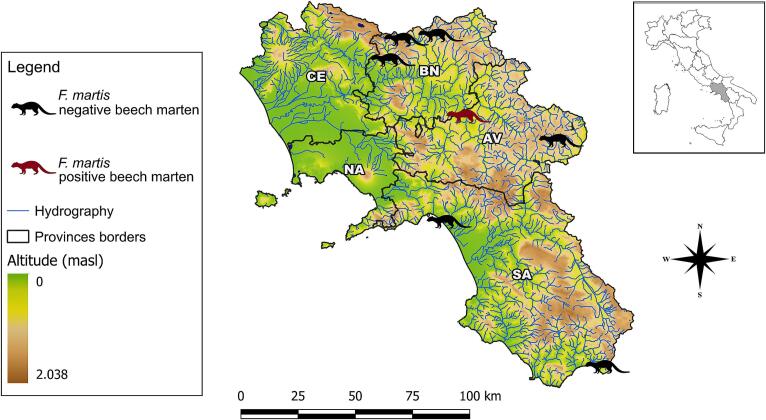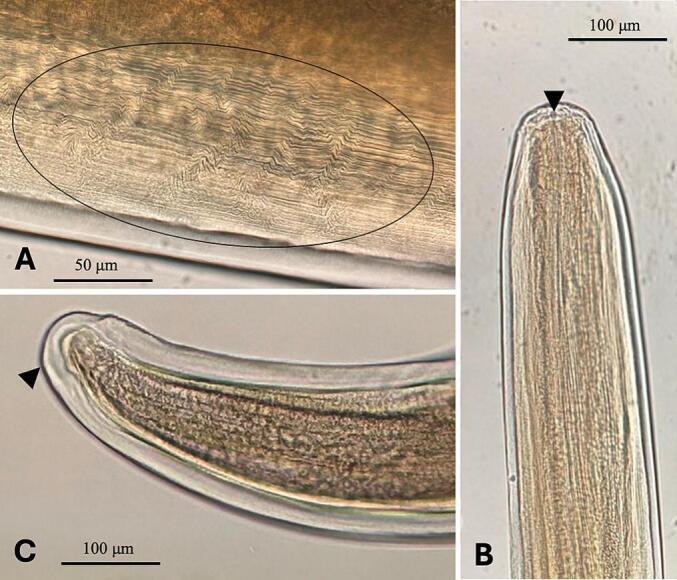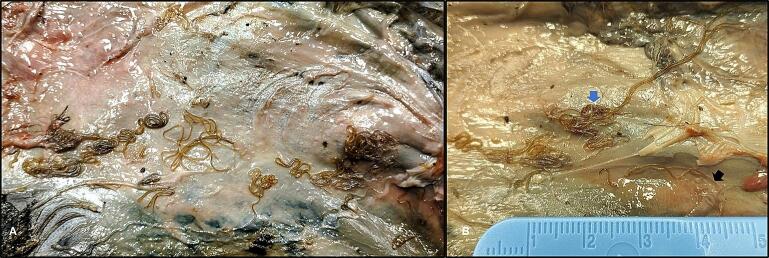Massive subcutaneous filariosis by Filaria martis in beech marten (Martes foina) in Italy
IF 2.4
Q3 INFECTIOUS DISEASES
引用次数: 0
Abstract
The beech marten (Martes foina) is a small-size mustelid endangered according to the IUCN Red List. Despite the plethora of parasites potentially affecting its population decline, subcutaneous filarioids are occasionally reported in martens and their competent arthropod vectors are to date unknown. Therefore, from January 2023 to August 2024, this study investigated the presence of subcutaneous filarioids and ectoparasites of road-killed beech martens (n = 7) from southwestern Italy. One marten (14.3 %, 95 % CI: 2.6–51.3) was massively infected with subcutaneous filarioids, i.e., 18 specimens (11 males and 7 females) in the dorso-posterior region, where mild redness and sloughing of skin were found. All the filarioids were identified as Filaria martis via morphology and Sanger sequencing of the cytochrome c oxidase subunit I (cox1) gene that revealed a single sequence type (GenBank accession number PQ034642) having 100 % nucleotide identity with those available in the literature. The phylogenetic analysis displayed a bootstrap value of 100 % between the cox1 sequences of F. martis of this study and those of beech martens from Italy and European minks from Spain. Haemolymph, gut, and salivary glands of the Ixodes ricinus ticks collected from the infected marten scored negative for F. martis larvae and DNA by dissection and PCR, respectively. This study reported for the first time F. martis subcutaneous filariosis in southwestern Italy, previously outlined only in northern and southeastern areas, indicating the circulation of this poorly investigated filarioid. Knowledge of the competent vectors involved in the biological cycle of F. martis requires further experimental studies.



意大利山毛榉貂(Martes foina)的毛丝虫引起的大量皮下丝虫病。
山毛榉貂(Martes foina)是一种小型鼬,根据世界自然保护联盟红色名录濒临灭绝。尽管大量寄生虫可能影响其种群数量的下降,但偶尔在貂类中报道皮下丝虫病,其称职的节肢动物媒介迄今尚不清楚。因此,从2023年1月至2024年8月,本研究调查了意大利西南部道路死亡的山毛榉马丁(n = 7)皮下丝虫病和体外寄生虫的存在情况。1只貂(14.3%,95% CI: 2.6-51.3)在背-后区大量感染皮下丝虫病,即18只貂(11只雄性和7只雌性),发现皮肤轻度发红和脱皮。通过细胞色素c氧化酶亚基I (cox1)基因的形态学和Sanger测序,所有丝状体均被鉴定为毛丝虫,发现单一序列类型(GenBank登录号PQ034642)与文献中发现的序列类型核苷酸同源性100%。系统发育分析表明,本研究的貂cox1序列与意大利的山毛榉貂和西班牙的欧洲水貂的cox1序列具有100%的自举值。从感染的貂身上采集的蓖麻蜱的血淋巴、肠道和唾液腺分别经解剖和PCR检测为阴性。本研究首次报道了意大利西南部的马氏F.皮下丝虫病,以前仅在北部和东南部地区概述,表明这种研究较少的丝虫病的循环。对参与火星螺旋体生物循环的相关媒介的了解需要进一步的实验研究。
本文章由计算机程序翻译,如有差异,请以英文原文为准。
求助全文
约1分钟内获得全文
求助全文
来源期刊

Parasite Epidemiology and Control
Medicine-Infectious Diseases
CiteScore
5.70
自引率
3.10%
发文量
44
审稿时长
17 weeks
期刊介绍:
Parasite Epidemiology and Control is an Open Access journal. There is an increasing amount of research in the parasitology area that analyses the patterns, causes, and effects of health and disease conditions in defined populations. This epidemiology of parasite infectious diseases is predominantly studied in human populations but also spans other major hosts of parasitic infections and as such this journal will have a broad remit. We will focus on the major areas of epidemiological study including disease etiology, disease surveillance, drug resistance and geographical spread and screening, biomonitoring, and comparisons of treatment effects in clinical trials for both human and other animals. We will also look at the epidemiology and control of vector insects. The journal will also cover the use of geographic information systems (Epi-GIS) for epidemiological surveillance which is a rapidly growing area of research in infectious diseases. Molecular epidemiological approaches are also particularly encouraged.
 求助内容:
求助内容: 应助结果提醒方式:
应助结果提醒方式:


